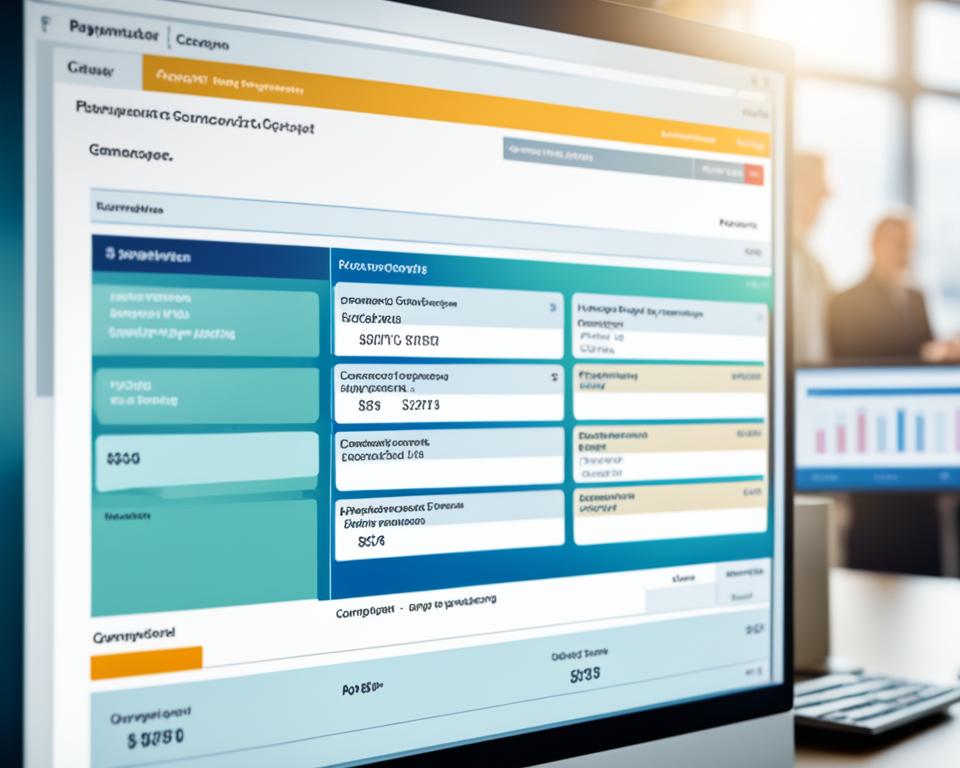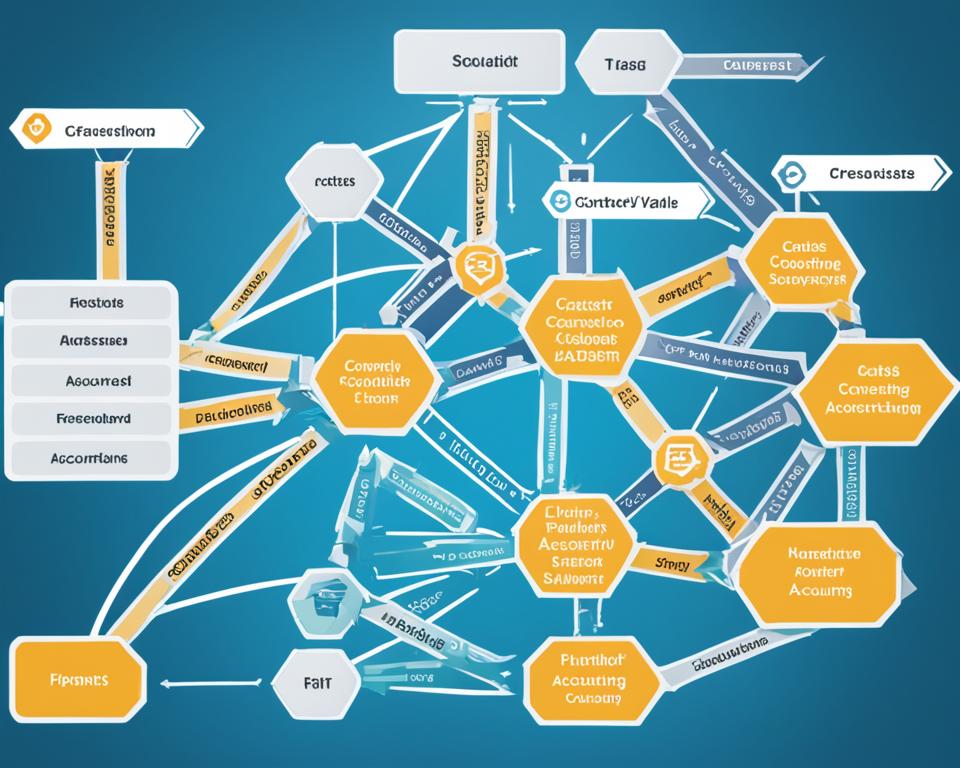Imagine if the secret to making your business run smoothly was mastering SAP FI. In today’s fast-paced business world, having effective financial integration is crucial. SAP FI is a powerful tool that helps businesses manage their finances better. It makes financial processes work together smoothly.
By using SAP FI, companies can improve their financial reports and accounting. This leads to better decisions and more efficient operations. Let’s see how SAP FI can change how you manage your finances and increase profits.
Key Takeaways
- SAP FI enhances financial integration across various business processes.
- Streamlined financial reporting leads to better decision-making.
- Operational effectiveness is greatly improved through SAP FI’s features.
- Mastering SAP FI can significantly boost business profitability.
- Real-time data processing facilitates responsive financial management.
- A comprehensive approach to financial accounting is vital for success.
Understanding SAP FI: An Overview
SAP FI is key in the SAP ERP world, making sure businesses handle their finances smoothly. It’s designed to manage many financial tasks. It includes handling accounts receivable, accounts payable, and asset accounting.
This system doesn’t just make things run better. It also helps with financial reports and following the rules. For example, it keeps track of finances accurately and gives updates on the company’s financial health.
For companies wanting to get better at managing money, knowing SAP FI is vital. Learning about it brings big benefits like clearer financial dealings and easier reports. SAP FI is crucial in SAP ERP, supporting important business tasks.
For those wanting to learn more, ABAP (Advanced Business Application Programming) is key. It helps customize SAP FI for specific business needs, as explained in this overview.
The Importance of Financial Integration
Integrating financial processes within a business is key to better operations. It helps with smooth business operations and makes things run more efficiently. Using tools like SAP FI makes complex financial tasks simpler.
Automating financial tasks cuts down on errors, making data management more reliable. It also means getting financial reports in real-time. This helps leaders make quick, informed decisions. Companies using these systems see better financial transparency and follow rules more closely.

- Enhanced Data Analysis: Financial integration helps with better data analysis, giving leaders useful insights.
- Improved Collaboration: Teams can work together better across departments, leading to better financial management.
- Increased Accountability: With streamlined operations, there’s more accountability in financial reports.
Financial integration can really boost business performance. It shows why companies should focus on these processes as they go digital.
| Benefit | Description |
|---|---|
| Efficiency | Reduces time spent on manual data entry and reconciliations. |
| Accuracy | Minimizes errors through automated financial processes. |
| Visibility | Provides real-time access to financial data across the organization. |
| Compliance | Enhances the ability to meet regulatory requirements with accurate reporting. |
Key Components of SAP FI
The success of SAP FI relies on key SAP FI components that make financial tasks easier. Each financial module plays a special role in managing finances well. These modules are:
- General Ledger Accounting: This is the core for bringing together all financial data.
- Accounts Payable: It handles vendor invoices and payments, making processes smoother.
- Accounts Receivable: It helps with billing and getting money from customers.
- Asset Accounting: Keeps track of company assets and their value and wear.
- Cash Management: It helps manage cash flow and keeps an eye on cash levels.
These modules work together through integration points. This teamwork makes financial reports and analysis better, boosting efficiency. For example, combining Ariba with SAP ERP makes buying things better, improving how companies work with suppliers and making smarter choices. You can learn more about this here.
Using these SAP FI parts helps companies get clear financial data, follow rules better, and do better overall.
| Component | Function | Benefits |
|---|---|---|
| General Ledger Accounting | Consolidates financial transactions | Provides a complete view of financial status |
| Accounts Payable | Handles vendor invoices and payments | Increases efficiency and reduces errors |
| Accounts Receivable | Manages billing and collections | Improves cash flow and customer relationships |
| Asset Accounting | Tracks and depreciates company assets | Optimizes asset utilization and reporting |
| Cash Management | Monitors and forecasts cash flow | Enhances liquidity and reduces risk |
SAP FI and Financial Accounting
SAP FI is key for good financial accounting in companies. It links SAP FI financial accounting with important processes. This makes managing financial data and reports more efficient. It also makes tracking financial transactions smooth.
Knowing how SAP FI works helps companies get important data. This data is crucial for making accurate financial statements. Meeting accounting standards is a must for any business. SAP FI helps make sure these standards are followed.
This system makes managing finances better by giving real-time updates. It helps with financial operations.
Tools like ABAP reports help improve financial accounting. They support managing transactions and help data analysts get insights from financial data. For tips on mastering ABAP reports, check out this resource.
| Feature | Description | Benefits |
|---|---|---|
| Real-Time Monitoring | Tracks transactions as they occur. | Immediate insights into financial status. |
| Automated Reporting | Generates financial statements without manual input. | Reduces errors and saves time. |
| Regulatory Compliance | Ensures adherence to financial regulations. | Avoids penalties and promotes trust. |

General Ledger Accounting in SAP FI
General ledger accounting is key in SAP FI. It’s the main place for all financial data. It shows the money moves of the company. This data is used to make detailed financial reports.
Defining General Ledger Accounting
In SAP FI, general ledger accounting means recording financial transactions carefully. It makes sure all money activities are tracked right. This includes everything from making money to spending it. Every entry changes the company’s financial picture and must be watched closely.
Importance of General Ledger in Financial Reporting
Having correct general ledger accounting is vital for good financial reports. It brings together all financial info. This info is used to make reports that show the company’s financial health.
These reports help in making decisions and planning for the future. Managing the general ledger well makes sure these reports are reliable. This means everyone can trust the financial info.
| Key Elements | Significance in General Ledger Accounting |
|---|---|
| Accuracy | Ensures precise financial data entry, critical for reporting. |
| Timeliness | Facilitates real-time updates to financial information. |
| Compliance | Meets regulatory standards and requirements for financial reporting. |
| Reconciliation | Ensures discrepancies are identified and corrected promptly. |
Managing Accounts Payable with SAP FI
Keeping an eye on accounts payable is key for a company’s financial health. SAP FI makes this easier, speeding up the process and making it more accurate. With automated processes, managing accounts payable becomes more efficient.
Overview of Accounts Payable Process
The process starts when a vendor sends an invoice. SAP FI checks the invoice against purchase orders and goods received. This step ensures everything matches before it goes into the system.
After checking, the invoice is ready for payment. SAP FI’s automated processes help track, approve, and schedule payments. This cuts down on mistakes and makes sure payments are on time.
Benefits of Automated Accounts Payable
Using SAP FI for automated accounts payable brings big benefits:
- Faster Processing Times: Automation cuts down the time spent on manual work, making the workflow more efficient.
- Improved Accuracy: With less human touch, the chance of errors in processing invoices goes down.
- Enhanced Vendor Relationships: Paying on time builds trust with vendors.
- Optimized Cash Flow Management: Automated processes help with better payment scheduling and cash flow analysis.

Enhancing Accounts Receivable Functionality
Managing accounts receivable well is key to keeping a steady cash flow in any business. Using SAP FI makes this easier by automating and making processes like invoicing, credit checks, and collections smoother. These tools make financial tasks more efficient and accurate.
With SAP FI, sending out invoices is easy, which means quicker fixes and fewer mistakes. This means better cash flow management, as customers pay faster. The software also has tools to check if customers can pay back on time, reducing the risk of late payments.
Linking accounts receivable with SAP FI gives a full view of financial data. This leads to deeper insights into cash flow and forecasting. It helps me keep track of invoices and manage collections better. This way, businesses can plan better to keep their cash flow strong and improve financially.
| Feature | Benefit |
|---|---|
| Automated Invoicing | Reduces processing time and errors |
| Credit Management | Minimizes risks of overdue payments |
| Integrated Financial Data | Enhances cash flow analysis and forecasting |
| Collection Management Tools | Improves efficiency in follow-ups and collections |
Using SAP FI to boost accounts receivable helps businesses run smoother and manage cash better. This leads to a stronger financial plan that supports growth and stability.
Asset Accounting: Maximizing Asset Value
In managing a business, asset accounting is key to making the most of a company’s assets. SAP FI’s asset accounting helps track when assets are bought, depreciated, and sold. Knowing how to manage these assets well can improve a company’s financial health.
Understanding Asset Accounting Basics
Asset accounting is all about keeping an eye on an asset’s life cycle. This includes buying it, tracking its value over time, and selling or writing it off. In SAP FI, I can sort assets by type and match them with financial goals. This way, every asset works hard for the company. I can keep an eye on important metrics to help plan for the future.
Integration with Other Financial Processes
Asset accounting in SAP FI works well with other financial tasks, like general ledger and accounts payable. This teamwork gives a full view of a company’s assets, making things run smoother. For example, when buying an asset, the cost shows up right in accounts payable, making sure the books are correct. The link with other systems helps make better decisions and manage assets well.

| Asset Type | Acquisition Cost | Current Value | Depreciation Method |
|---|---|---|---|
| Machinery | $50,000 | $30,000 | Straight-Line |
| Office Equipment | $10,000 | $5,000 | Declining Balance |
| Vehicles | $25,000 | $15,000 | Sum-of-the-Years’ Digits |
This strong connection lets me tie asset accounting to big financial goals. Using SAP FI for managing assets helps companies work better and stay financially strong.
Bank Accounting in SAP FI
The bank accounting module in SAP FI is key for better financial management. It makes sure financial transactions are smooth and correct. This module helps with cash management, which is good for an organization’s financial health.
Key Features of Bank Accounting Module
This module has many features that help with cash management. Here are some key ones that show how bank accounting boosts financial efficiency:
- Bank Reconciliations: Automates the process of comparing bank statements with the company’s records, ensuring accuracy and correcting discrepancies in real-time.
- Incoming and Outgoing Payments: Manages the inflow and outflow of cash effectively, allowing for quicker processing of transactions.
- Cash Position Analysis: Provides insights into available cash, helping with forecasting and planning for future expenses.
Using these features, organizations can make financial transactions smoother. An effective bank accounting system works well with other SAP FI parts, improving how financial resources are managed. For a full approach to managing money, check out SAP Ariba, which makes procurement better.
| Feature | Description | Benefit |
|---|---|---|
| Bank Reconciliation | Systematic comparison of bank transactions against internal records. | Enhances accuracy and reduces discrepancies. |
| Payment Processing | Streamlined handling of both incoming and outgoing payments. | Improves cash flow management. |
| Cash Position Analysis | Real-time overview of available cash across accounts. | Aids in better financial planning. |
Using strong bank accounting in SAP FI helps with cash management and financial stability. Knowing these key features lets businesses improve their financial operations.
Optimizing Cash Management Practices
Effective cash management is key to success. It helps businesses meet their financial needs and grab investment chances. By planning well and using the right tools, companies can manage their cash better and stay financially healthy.
Importance of Effective Cash Management
Having a strong cash position lets companies handle uncertainty with ease. A good cash management plan helps with:
- Timely payments of bills and debts.
- Forecasting cash needs to prevent shortfalls.
- Investing extra cash wisely to earn more.
Tools Available within SAP FI for Cash Management
SAP FI has tools to help with cash management and liquidity. Some important features are:
- Cash Position Reporting: Gives up-to-date info on cash balances.
- Cash Forecasting: Predicts cash flows using past data and trends.
- Bank Reconciliation: Makes reconciling bank statements easier and more accurate.

Streamlined Financial Closing Processes
Efficient financial closing is key to keeping financial records right and boosting a company’s performance. SAP FI helps businesses make their financial closing smoother. It makes month-end tasks easier to handle.
Financial closing steps include making reconciliations, posting journal entries, and creating financial statements. SAP FI automates these tasks. This cuts down the time and lowers the chance of mistakes. It makes financial reports more accurate, helping companies make quick, smart decisions.
Using SAP FI means following a set process for month-end tasks. I’ve seen how this makes financial teams work better. It brings consistency and clear steps, helping companies understand their finances and plan better.
Adding advanced analytics to financial closing gives key insights for planning. The system’s real-time data analysis shows a company’s financial health. This helps in better talks with stakeholders and improves teamwork on financial matters.
Using SAP FI sets up a strong way to handle financial closing. It lets me focus on big strategies instead of manual tasks. For better managing suppliers, adding Ariba Supplier Collaboration can bring more benefits. Learn more about improving supplier partnerships with this informative article.
Financial Reporting Capabilities in SAP FI
In SAP FI, financial reporting is key for keeping an eye on a company’s finances. It lets you see all the important financial reports like profit and loss statements, balance sheets, and cash flow statements. These reports are vital for making smart decisions and following the law.
Types of Financial Reports
SAP FI offers many types of reports for a deep look into financial trends and performance. You can easily find out about your spending and earnings. This helps in checking profits and managing money better. With these reporting capabilities, finance teams can spend more time on strategy and less on manual reports.
Real-Time Reporting Features
SAP FI is known for its real-time reporting. This means you get updates on your finances right away, avoiding the wait of old reporting methods. Real-time data helps businesses make quick, smart choices. This makes SAP FI a big help in financial reporting, giving a clear view of financial operations for success.
Explore more on how companiesleverage SAP capabilities
FAQ
What is SAP FI and how does it integrate with financial processes?
SAP FI stands for Financial Accounting. It’s a key part of the SAP ERP system. It helps manage financial processes like general ledger, accounts payable, and asset accounting. This makes financial reporting and decision-making better.
What key components are included in SAP FI?
SAP FI includes financial modules like general ledger and accounts payable. It also has asset accounting and cash management. These modules work together to help manage finances well and follow rules.
How does SAP FI ensure accurate financial reporting?
SAP FI keeps financial reporting accurate by managing transactions well. It uses a detailed general ledger and combines data from accounts payable and receivable. This helps make financial statements reliable, supporting financial control and following accounting standards.
What benefits can businesses gain from utilizing accounts payable management in SAP FI?
Using accounts payable management in SAP FI automates invoice processing. This cuts down on manual errors and speeds up processing. It helps improve vendor relationships, ensure timely payments, and manage cash flow better.
In what ways does SAP FI enhance accounts receivable functionality?
SAP FI boosts accounts receivable with features for invoicing and credit management. This integration helps manage cash flow well. It also improves cash flow analysis and forecasting, helping with liquidity management.
Why is asset accounting important within SAP FI?
Asset accounting is crucial in SAP FI for tracking assets. It helps manage their acquisition, depreciation, and disposal. This ensures financial statements show the company’s true financial health.
What role does bank accounting play in financial management with SAP FI?
Bank accounting in SAP FI is key for managing cash flow. It helps with bank reconciliations, payment processing, and cash analysis. These activities improve cash management and financial stability.
How does SAP FI support optimized cash management practices?
SAP FI helps with cash management through tools for liquidity and cash forecasting. This ensures businesses have enough liquidity and can take advantage of investment opportunities.
Can SAP FI streamline financial closing processes?
Yes, SAP FI makes financial closing faster by automating month-end tasks and standardizing procedures. This leads to quicker closing times, more accurate reports, and better planning for decisions.
What types of financial reports can be generated with SAP FI?
SAP FI can create financial reports like profit and loss statements and balance sheets. Its real-time reporting helps organizations make timely strategic decisions.


